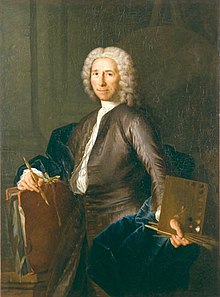|
Henri de Favanne
 Henri Antoine de Favanne or Favannes (3 October 1668 – 27 April 1752) was an English-born French painter of historical subjects. LifeHe was born in London on 3 October 1668, and returned to France with his family in 1688.[1] He studied under René Houasse, a pupil of Charles le Brun.[2] He went to Italy in 1693, and was awarded the Grand Prix de Rome in 1693. He then spent ten years in Spain[3] in the service of Madame des Ursins.[2] In 1714 he returned France, where he was commissioned by Madame des Ursins' secretary Jean d’Aubigny to decorate the newly built Château de Chanteloup.[1][2] There he painted the gallery – decorating it with ten scenes from the life of Philip V – a salon and the chapel. The château no longer exists, but there are three studies for decorations in the gallery in French public collections: The Triumph of Justice in the Louvre, The Kingdoms of Valencia and Aragon Surrender to Philip V in the Musée des Beaux-Arts at Lille and The Battle of Almança or The Battle of Villaviciosa acquired by Musée des Beaux-Arts at Tours in 2007. The museum at Tours also owns two paintings by Favanne which used to hang in the chateau, and a study for a work in the salon.[2] In Paris, he was elected rector of the Academy. He died on 27 April 1752.[3] References
Sources
|
||||||||||||
